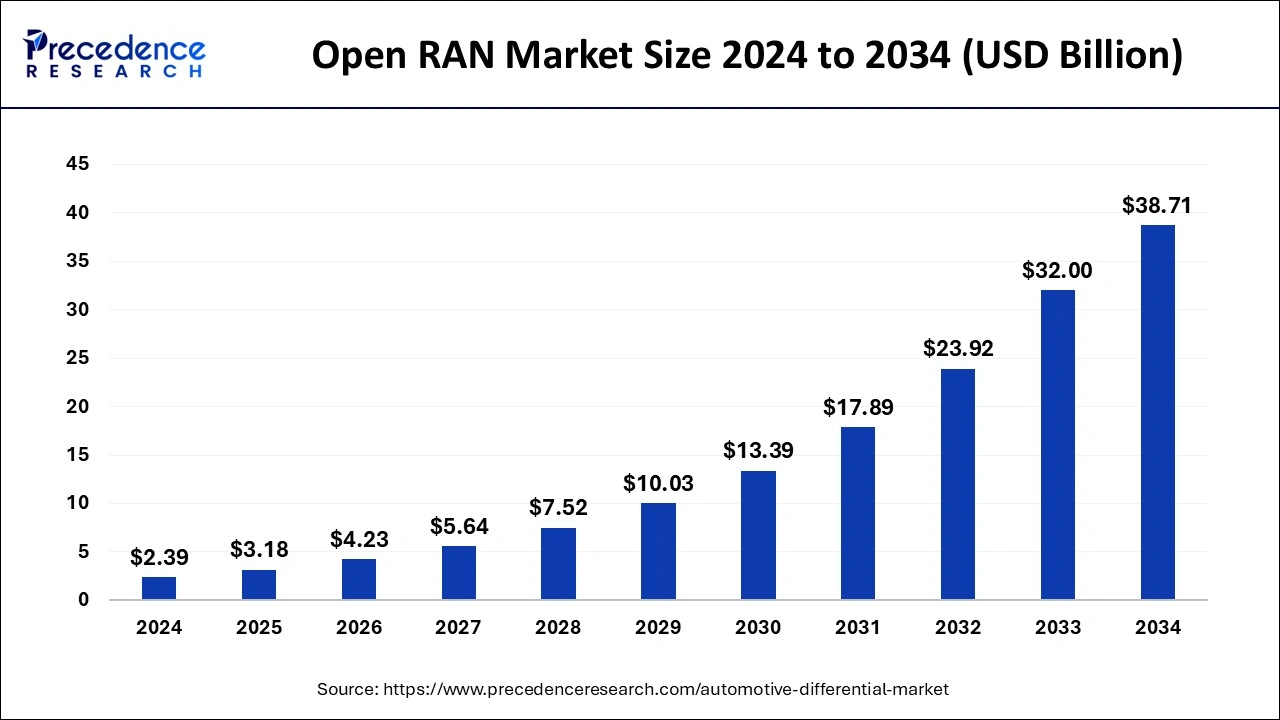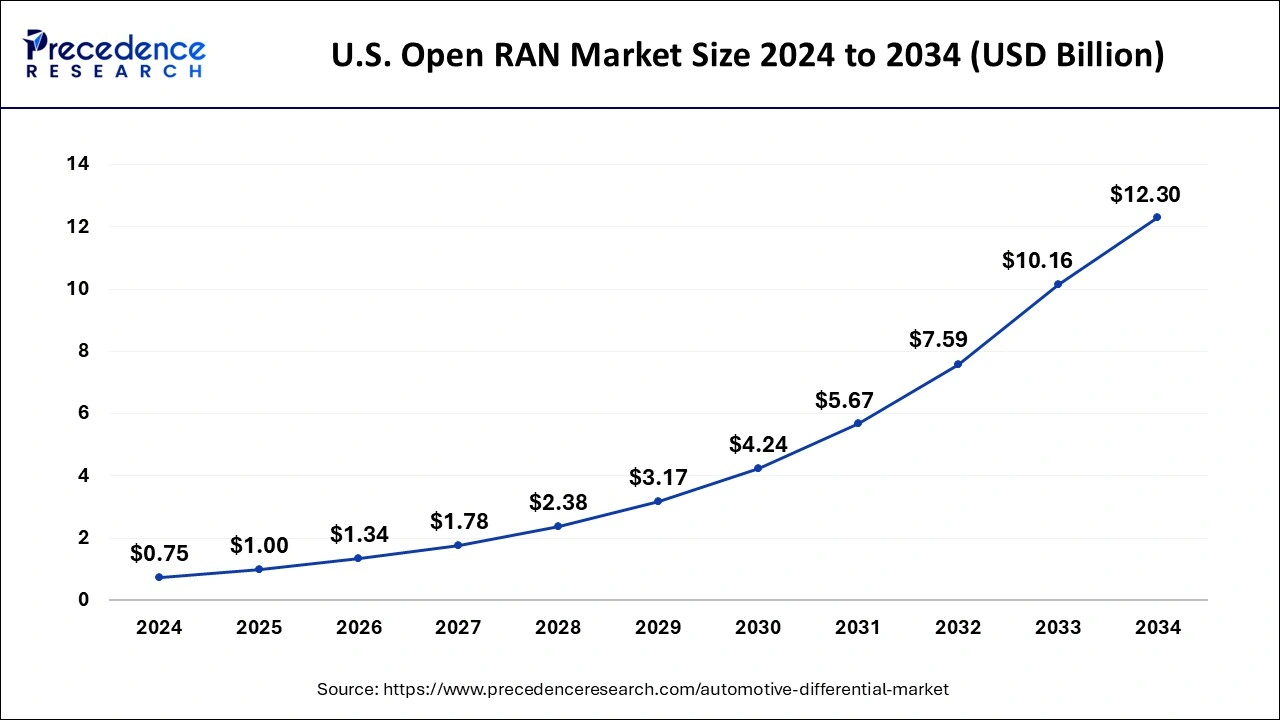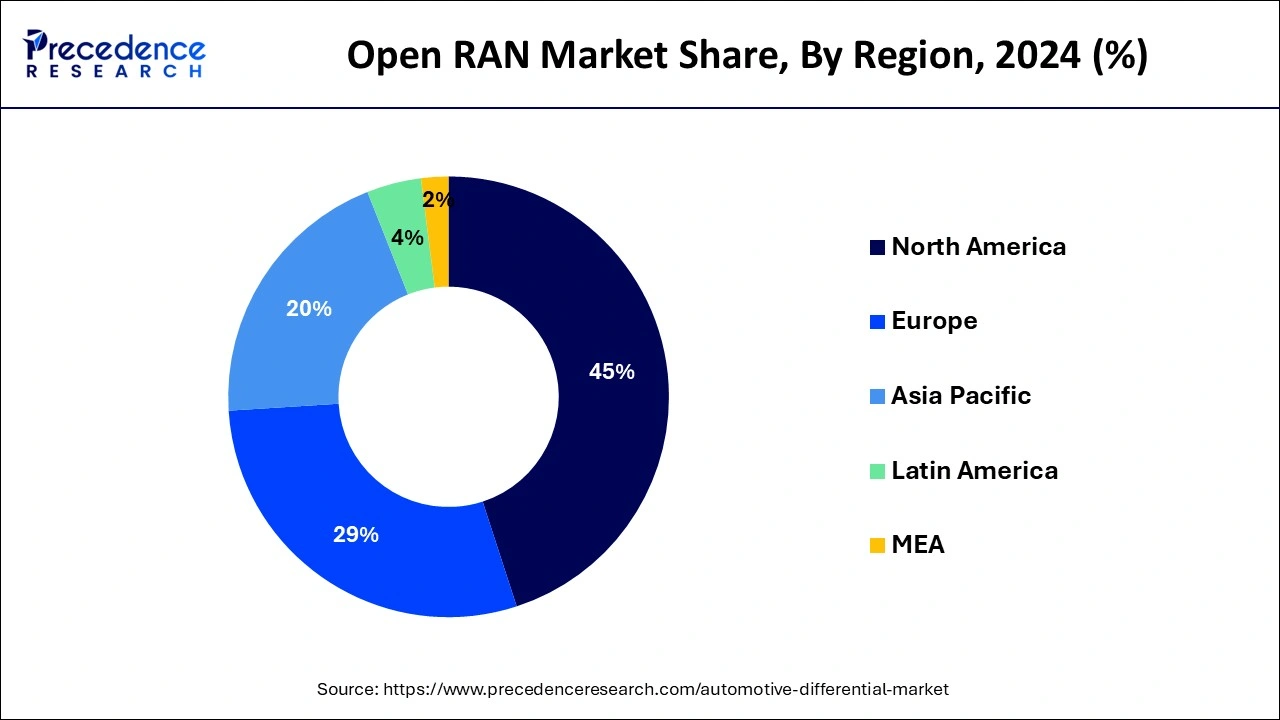October 2024
The global open RAN market size is calculated at USD 3.18 billion in 2025 and is forecasted to reach around USD 38.71 billion by 2034, accelerating at a CAGR of 32.11% from 2025 to 2034. The North America open RAN market size surpassed USD 1.08 billion in 2024 and is expanding at a CAGR of 32.20% during the forecast period. The market sizing and forecasts are revenue-based (USD Million/Billion), with 2024 as the base year.
The global open RAN market size was estimated at USD 2.39 billion in 2024 and is predicted to increase from USD 3.18 billion in 2025 to approximately USD 38.71 billion by 2034, expanding at a CAGR of 32.11% from 2025 to 2034.

The U.S. open RAN market size was estimated at USD 0.75 billion in 2024 and is anticipated to reach around USD 12.30 billion by 2033, growing at a CAGR of 32.28% from 2025 to 2034.

North America held a market share of 45% in 2024 due to several factors. The region has witnessed extensive 5G deployments, driving the demand for flexible and innovative network solutions like open RAN. Additionally, regulatory support, strong investments in telecommunications infrastructure, and a robust ecosystem of technology providers contribute to North America's dominance. The market's growth is further propelled by a strategic focus on enhancing network efficiency, reducing costs, and fostering technological advancements, making North America a key player in the open RAN landscape.

The Asia-Pacific region is poised for rapid growth in the open RAN market due to increasing demand for cost-effective and flexible network solutions. As the region aggressively adopts 5G technology, open RAN's modular and interoperable approach resonates well with diverse market needs. Governments and telecom operators in Asia-Pacific are keen on leveraging open RAN to address connectivity challenges, enhance network efficiency, and promote vendor diversification. This surge in interest and investment positions the region as a key driver for the expansion and adoption of open RAN technologies.
Meanwhile, Europe is experiencing notable growth in the open RAN market due to a convergence of factors. The region's focus on fostering a diverse and competitive telecommunications landscape, along with initiatives to enhance network efficiency and reduce dependency on traditional vendors, has accelerated open RAN adoption. Furthermore, regulatory support for open and interoperable network architectures aligns with the objectives of open RAN, contributing to its widespread acceptance. This growth trend reflects Europe's commitment to technological innovation, cost-effectiveness, and building resilient, future-ready telecommunications infrastructures.
Open RAN, or open radio access network, is a revolutionary approach to building mobile networks. Unlike traditional systems where network components are tightly integrated and come from a single vendor, open RAN encourages a more open and interoperable environment. In simpler terms, it allows network operators to mix and match components from different suppliers, fostering competition and innovation. This flexibility enables cost-effective deployment and scaling of mobile networks, promoting a more diverse and competitive marketplace. Open RAN aims to break down vendor lock-in, enhance network efficiency, and accelerate the adoption of advanced technologies like 5G, ultimately providing better services to users and fostering a more dynamic and collaborative ecosystem within the telecommunications industry.
| Report Coverage | Details |
| Growth Rate from 2025 to 2034 | CAGR of 32.11% |
| Market Size in 2025 | USD 3.18 Billion |
| Market Size by 2034 | USD 38.71 Billion |
| Base Year | 2024 |
| Forecast Period | 2025 to 2034 |
| Segments Covered | By Component, By Unit, and By Deployment |
| Regions Covered | North America, Europe, Asia-Pacific, Latin America, and Middle East & Africa |
Ecosystem collaboration
Ecosystem collaboration is a key driver behind the surge in market demand for open RAN. As telecom operators, equipment manufacturers, and technology developers join forces, they create a unified front that fosters innovation and standardization. This collaboration ensures that different components from various vendors seamlessly work together, promoting interoperability. With shared best practices and standardized approaches, the open RAN ecosystem becomes more cohesive, reducing complexities for operators.
Furthermore, industry collaboration instills confidence in the market, assuring stakeholders of the reliability and efficiency of open RAN solutions. As a result, telecom operators are more inclined to adopt open RAN technologies, leading to increased market demand. The collective efforts of the ecosystem not only drive innovation but also establish a strong foundation for the widespread adoption of open RAN, contributing significantly to its growth in meeting the evolving needs of the telecommunications industry.
Lack of standardization
The lack of standardization poses a significant restraint on the market demand for Open RAN. Without universally accepted interfaces and protocols, the integration of diverse components from different vendors becomes challenging for network operators. This absence of standardized practices complicates the selection and coordination of equipment, hindering the seamless interoperability that open RAN promises. Operators may hesitate to fully embrace open RAN solutions due to the uncertainty and potential complications arising from the absence of standards.
The lack of a common framework can lead to increased integration costs, longer deployment times, and operational inefficiencies. Standardization is crucial for building trust in the reliability and compatibility of open RAN technologies, and until this challenge is addressed, the broader adoption of open RAN may face resistance from operators seeking a more cohesive and standardized approach to their network infrastructure.
Vendor diversification
Vendor diversification stands as a pivotal opportunity in the open RAN (Open Radio Access Network) market, fostering a more competitive and dynamic landscape. The modular architecture of open RAN allows telecom operators to choose components from various vendors, reducing reliance on a single supplier. This diversity not only opens up a range of options for operators but also stimulates healthy competition among equipment manufacturers. With vendor diversification, operators can select the best-in-class solutions for their specific needs, promoting innovation and efficiency. This opportunity encourages manufacturers to continuously improve their offerings to stay competitive in the market.
As a result, the open RAN ecosystem becomes more resilient and adaptable, leading to enhanced product quality, cost-effectiveness, and overall improvements in the telecommunications infrastructure. Vendor diversification thus plays a crucial role in shaping a vibrant and innovative open RAN market, ultimately benefiting both operators and consumers by providing a broader array of choices and driving advancements in network technologies.
The hardware segment held the highest market share of 49% in 2024. In the open RAN market, the hardware segment comprises the physical components essential for radio access network functionalities. This includes radio units, antennas, and baseband units. The hardware segment is witnessing a trend towards greater flexibility and interoperability, aligning with the open architecture of open RAN. Vendors are focusing on developing modular and standardized hardware solutions, allowing telecom operators to mix and match components from different suppliers. This trend enhances vendor diversification, promotes cost efficiency, and supports the evolution of open RAN towards a more dynamic and adaptable network infrastructure.
The services segment is anticipated to witness rapid growth at a significant CAGR of 35.3% during the projected period. In the open RAN market, the services segment encompasses various offerings related to the deployment, maintenance, and optimization of open RAN networks. These services include installation, integration, consulting, and ongoing support to ensure the efficient functioning of the network. A notable trend in this segment involves the growing demand for consulting services as operators seek guidance on the optimal deployment and management of open RAN. As the market evolves, service providers are also focusing on enhancing their support offerings to address the unique challenges associated with the implementation and operation of open RAN solutions.
The radio unit segment has held a 39% market share in 2024. In the open RAN market, the radio unit segment refers to the component responsible for radio frequency signal processing and transmission. It plays a key role in connecting mobile devices to the network. A notable trend in this segment is the disaggregation of radio unit functionalities, allowing for interoperability between different vendors. This trend promotes flexibility for network operators, enabling them to choose and integrate radio units from diverse suppliers, and fostering competition and innovation within the open RAN ecosystem.
The distributed unit segment is anticipated to witness rapid growth over the projected period. In the open RAN market, the distributed unit refers to a segment of the network architecture responsible for processing and managing radio signals. This unit is distributed across various locations, enabling flexibility in network deployment. A key trend in this segment involves the adoption of virtualization and cloud-native technologies, allowing for more efficient and scalable network operations. This trend aligns with the broader movement towards disaggregated and open architectures in the telecommunications industry, facilitating the development of innovative solutions and enhancing the overall performance of open RAN networks.
The hybrid cloud segment has held a 50% market share in 2024. In the open RAN market, the hybrid cloud segment refers to the deployment model where a combination of on-premises and cloud-based infrastructure is utilized. This allows operators to leverage the benefits of both environments, optimizing resource utilization and ensuring flexibility. A key trend in the open RAN market is the increasing adoption of hybrid cloud deployments. This approach allows operators to balance the need for low-latency processing at the edge (on-premises) with the scalability and cost-efficiency offered by cloud resources, catering to diverse network requirements.
The private cloud segment is anticipated to witness rapid growth over the projected period. In the open RAN market, the private cloud segment refers to the deployment of open RAN solutions within a dedicated and secure cloud infrastructure operated by an individual organization. This deployment model ensures exclusive control over resources, enhancing security and customization. A growing trend in the open RAN private cloud segment involves enterprises and service providers adopting this approach for more efficient and tailored network management, allowing them to leverage the benefits of open RAN while maintaining control and security within their private cloud environments.
By Component
By Unit
By Deployment
By Geography
For inquiries regarding discounts, bulk purchases, or customization requests, please contact us at sales@precedenceresearch.com
No cookie-cutter, only authentic analysis – take the 1st step to become a Precedence Research client
October 2024
July 2024